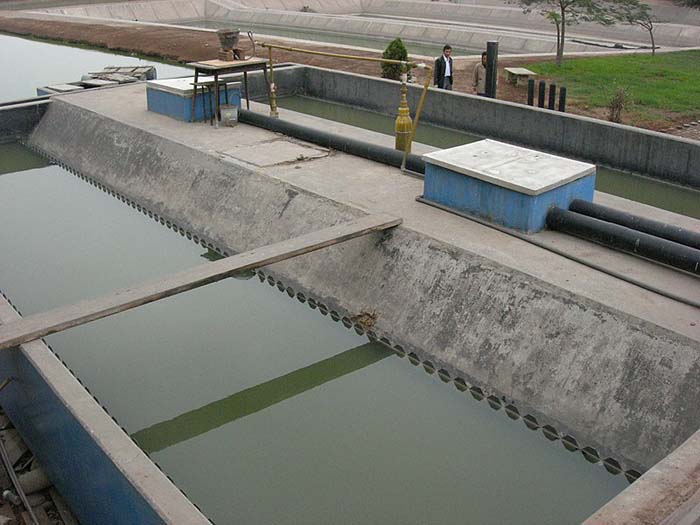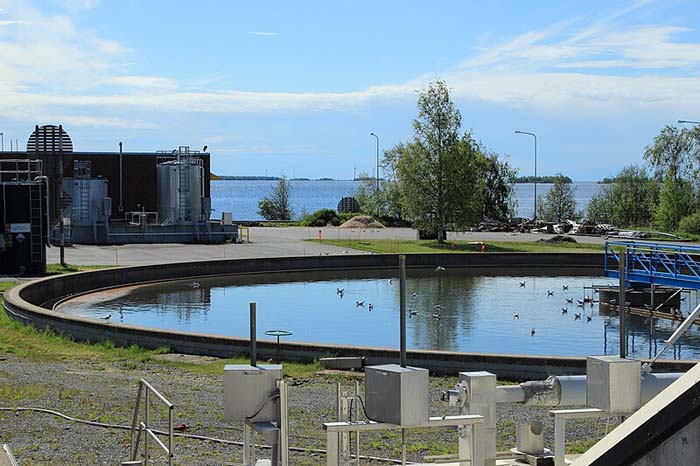
The primary goal of wastewater treatment is to remove harmful substances from the water. This process prepares the water for reuse or release back into the environment. It greatly impacts sustainable water management, ecosystem preservation, and human health.
The 3 stages of wastewater treatment are?
- Primary Treatment
Primary wastewater treatment is the first step in cleaning wastewater before discharging it back into the environment. Physical procedures help to filter out large particles and other objects from the wastewater. Sedimentation allows heavier solids to sink to the bottom of basins or tanks after screening removes large particles like plastics, rags, and twigs.
The first treatment reduces the amount of organic matter and solids in the wastewater to improve the treatment process’s efficiency and effectiveness. Nevertheless, further secondary and tertiary treatment procedures are necessary to eliminate pathogens and dissolved contaminants.
Primary wastewater treatment offers several benefits:
- Ensuring conformity with regulations
Environmental regulations require wastewater to undergo treatment before it is released into bodies of water. Primary treatment helps facilities conform to these standards set by regulators as a first step in wastewater treatment.
- Organic matter reduction
Because it allows settleable materials to settle at the bottom of basins or tanks, it helps lower the organic load in the wastewater. As a result, the need for oxygen during treatment procedures has decreased.
- Decreased risk of equipment damage
Primary treatments reduce maintenance costs and downtime. Large solids do not damage downstream equipment like filters, valves, and pumps.
- Affordable
Advanced treatment procedures can be expensive and complex, whereas primary treatment is easy and inexpensive. It is a low-cost wastewater treatment solution that uses fewer chemicals and less energy.
- Preparation for secondary treatment
Primary treatment removes a large amount of organic matter and sediments from the wastewater to make secondary and tertiary treatment procedures run more smoothly. It enhances the treatment plant’s overall performance.
- Reduction of smells
The removal of solids during primary treatment reduces the production of wastewater odors, enhancing the quality of the treatment facility’s surroundings.
- Removing large solids
The wastewater undergoes primary treatment before it becomes clogged with large items like plastics, rags, sticks, and other trash at the treatment plant’s pumps and pipes.
- Secondary Treatment:
After the first stage of wastewater treatment, known as primary treatment, the process moves on to secondary treatment. Secondary treatment removes suspended and dissolved biological matter, further purifying the water. This stage typically employs biological techniques to decompose the organic compounds present in the wastewater.
Rotational biological contactors, trickling filters, and activated sludge processes are popular methods utilized in secondary treatment. These procedures involve introducing microbes into wastewater. The microbes use the wastewater as food to break down organic contaminants into water, carbon dioxide, and other microbes. This reduces the demand for suspended particles and biochemical oxygen, making the wastewater safer to discharge into the environment.
Wastewater treatment plants conduct secondary treatment to ensure the treated water is up to standard before releasing it back into the water or using it for irrigation or other purposes.
The advantages of secondary wastewater treatment
Before its release back into the environment, treated wastewater undergoes secondary treatment. This helps to improve its quality in a variety of ways:
- Ecosystem protection
Secondary treatment protects and restores coastal areas, lakes, and rivers. It helps to remove contaminants and minimizes the nutrient load in wastewater. This helps to promote biodiversity and ecological balance.
- Removal of biological pollutants
Microbes in biological processes make secondary treatment effective at breaking down organic contaminants. This reduces the wastewater’s chemical and biochemical oxygen demands. This means receiving waters are less likely to experience oxygen depletion and habitat damage.
- Support for water reuse
Treated wastewater from secondary treatment procedures can be used for non-potable reuse, such as groundwater recharge, industrial processes, and landscape irrigation. This reduces the demand for drinking water supplies and conserves freshwater resources.
- Support for water reuse
Treated wastewater from secondary treatment procedures can be used for non-potable reuse, such as groundwater recharge, industrial processes, and landscape irrigation. This reduces the demand for drinking water supplies and conserves freshwater resources.
- Less negative effects on the environment
Hypoxia and algal blooms are harmful consequences of nutrient pollution that can affect ecosystems and aquatic life. Secondary treatment helps reduce these impacts by removing the majority of contaminants from wastewater.
- Ensuring the well-being of the public
Secondary treatment reduces the risk of waterborne illness, especially in areas where treated wastewater may pollute potable water sources or come into contact with humans. It also safeguards public health by eliminating bacteria and other pathogens from wastewater.
- Ensuring conformity with rules
Many environmental regulations require wastewater treatment plants to meet certain waste quality criteria before discharging treated wastewater into receiving waterways. Secondary treatment helps facilities meet these standards, preventing legal issues and regulatory fines.
- Improved visual appeal
The secondary treatment enhances the aesthetic appeal and reduces undesirable odors in treated wastewater. It can play a significant role in gaining public acceptance and improving community relations.
- Higher-quality water
To make wastewater safer for human health and aquatic ecosystems, secondary treatment greatly reduces the concentration of pathogens, organic debris, suspended particles, and other contaminants.
- Tertiary Treatment:
After primary and secondary treatment, the next step in cleaning wastewater is tertiary treatment. In the first stage, sediments physically separate from the wastewater. In the second stage, biological processes help further remove pathogens and organic matter. Finally, in the third and final stage, tertiary treatment helps to improve the effluent quality further. When more extensive treatment is necessary to achieve certain water quality criteria or to make wastewater usable for positive uses, tertiary treatment is usually used.
Tertiary wastewater treatment often makes use of the following methods and procedures:
Adsorption
Activated carbon and other adsorbent materials help in adsorption to remove colorants, trace pollutants, and dissolved organic compounds from wastewater.
Disinfection
Disinfection is the process of killing or rendering inactive viruses, bacteria, and other pathogens in treated wastewater. The most common ways to disinfect water are chlorination, ozone treatment, and UV disinfection.
Advanced Oxidation Processes
Advanced oxidation processes use strong oxidizing agents, such as UV light, hydrogen peroxide, or ozone, to break down new pollutants, pharmaceuticals, and persistent organic pollutants in wastewater.
Removal of Nutrients
Tertiary treatment may also remove nutrients like phosphorus and nitrogen, exacerbating eutrophication and other water quality issues. Nutrient removal methods include chemical precipitation, sophisticated biological processes, and biological nutrient removal.
Filtration
To filter out bacteria, viruses, and other microorganisms, wastewater passes through a series of filters. These filters might be membrane, multimedia, or sand.
Membrane Processes
Membrane technologies such as UF, NF, and RO help extract microbes, salts, and dissolved pollutants from wastewater to obtain extremely high degrees of purification.
Benefits of tertiary wastewater treatment
- Reducing negative effects on the environment
Tertiary treatment decreases environmental disturbances caused by algal blooms and eutrophication by reducing the amount of contaminants and nutrients that reach receiving bodies of water.
- Community engagement and trust
Implementing tertiary treatment increases community trust and participation in wastewater management projects. This shows dedication to public health and environmental sustainability, which may encourage more people to support environmental practices and water conservation initiatives.

- Compliance with regulations
In many places, the quality of released wastewater is subject to strict standards. Tertiary treatment allows wastewater treatment plants to achieve even greater degrees of purification. This helps to meet these statutory standards and avoid penalties and fines for non-compliance.
- Support for sustainable development
Tertiary treatment aligns with sustainable development principles because it improves wastewater effluent quality. This is critical for long-term human and environmental well-being, as well as the responsible use and management of water resources.
- Public health protection
Communities that rely on water supplies downstream of wastewater treatment plants benefit from tertiary treatment protection from pollution and waterborne diseases. This process removes additional pollutants and pathogens.
- Economic advantages
Tertiary treatment can ultimately lead to long-term cost benefits by lowering the need for costly interventions to repair environmental damage caused by poorly treated or untreated wastewater, even if it may involve initial investment in technology and infrastructure.
- Water resource reclamation
Non-potable uses for tertiary-processed wastewater include groundwater recharge, industrial processes, and irrigation. There’s the promotion of sustainable water management techniques, the conservation of freshwater supplies, and the demand for potable water sources.
- Improved water quality
The last stage of wastewater treatment, tertiary treatment, involves removing any leftover contaminants, including suspended solids, phosphorous, and nitrogen. This process returns purified water to the environment, which is important for preserving aquatic ecosystems and providing safe drinking water.
Conclusion
Resource recovery, energy efficiency, and environmental concerns become more significant as wastewater treatment progresses. The treatment process is optimized to recover vital resources like water, nutrients, and energy while minimizing energy consumption and waste sludge formation.
To protect public health and the environment for current and future generations, wastewater treatment is an interdisciplinary field that integrates environmental sciences, biology, engineering, and chemistry to combat water scarcity and pollution.

